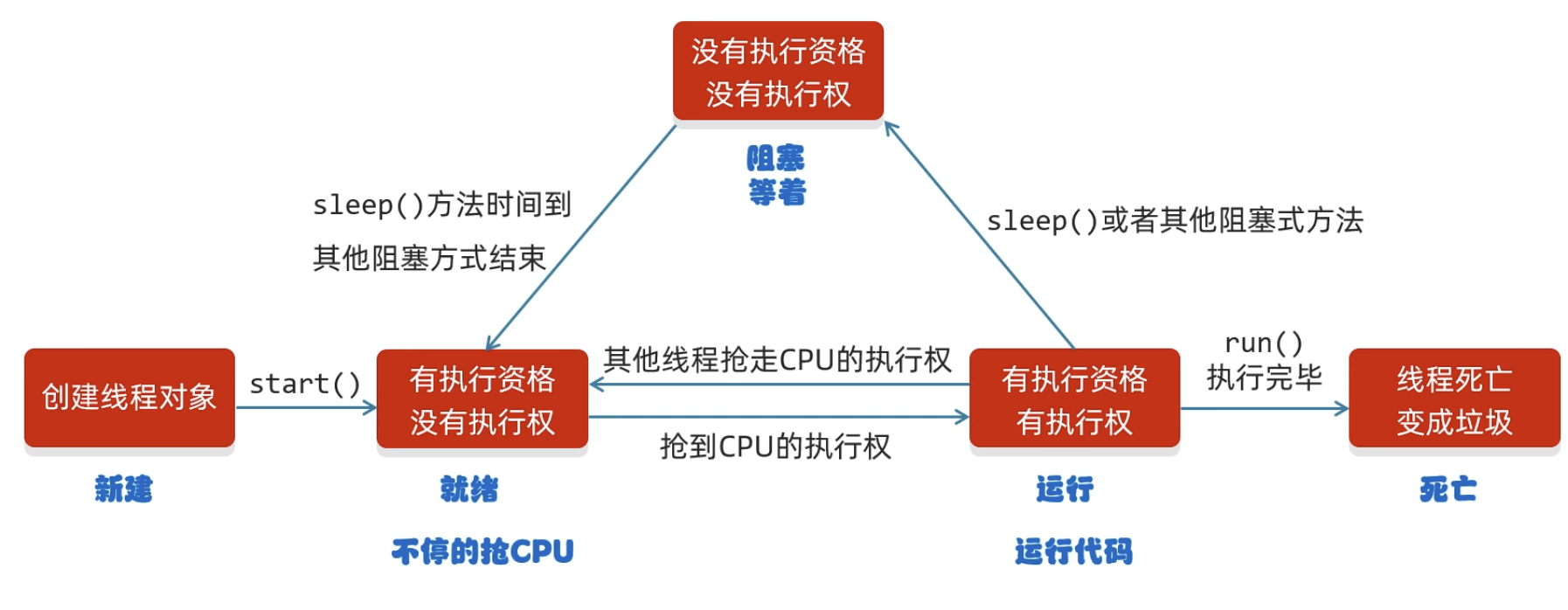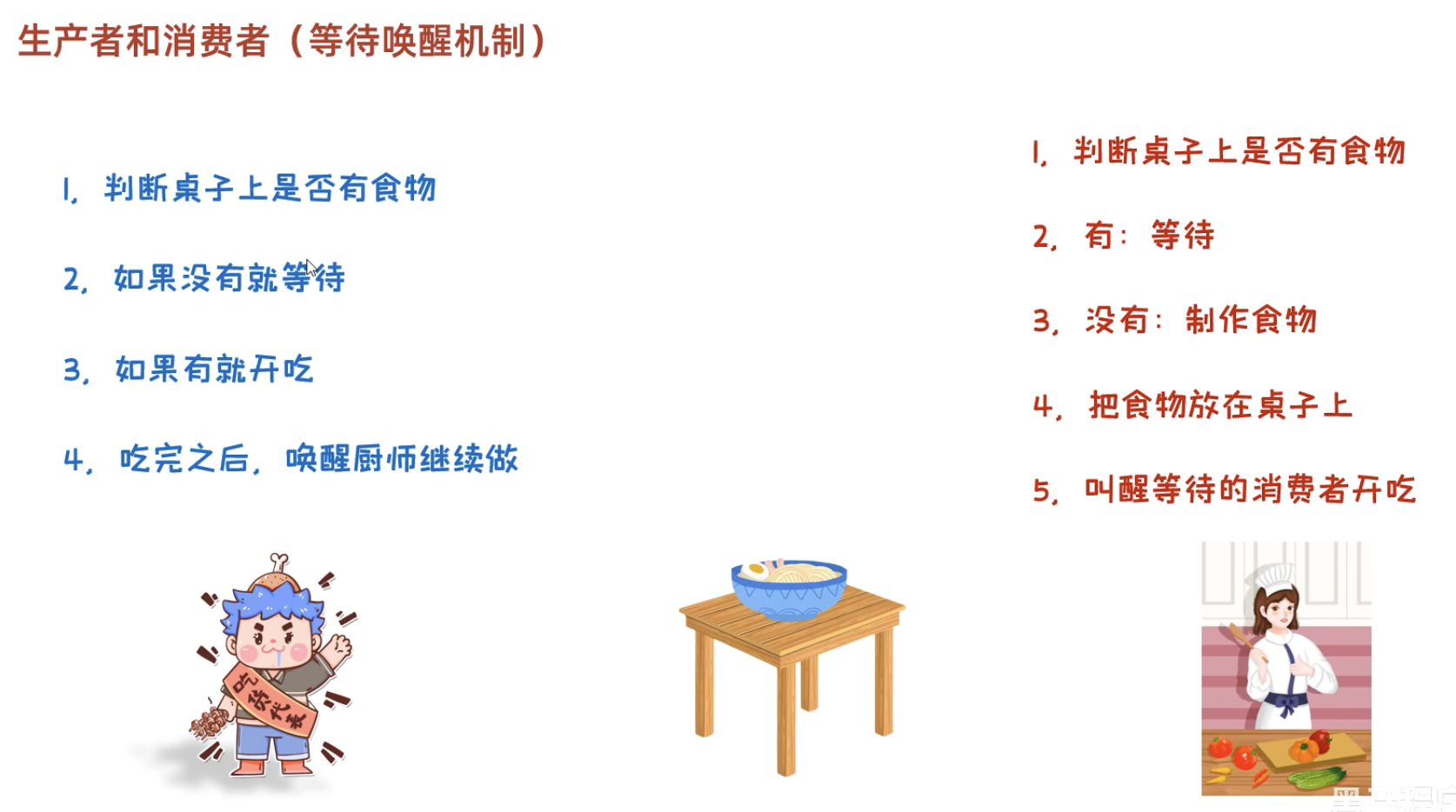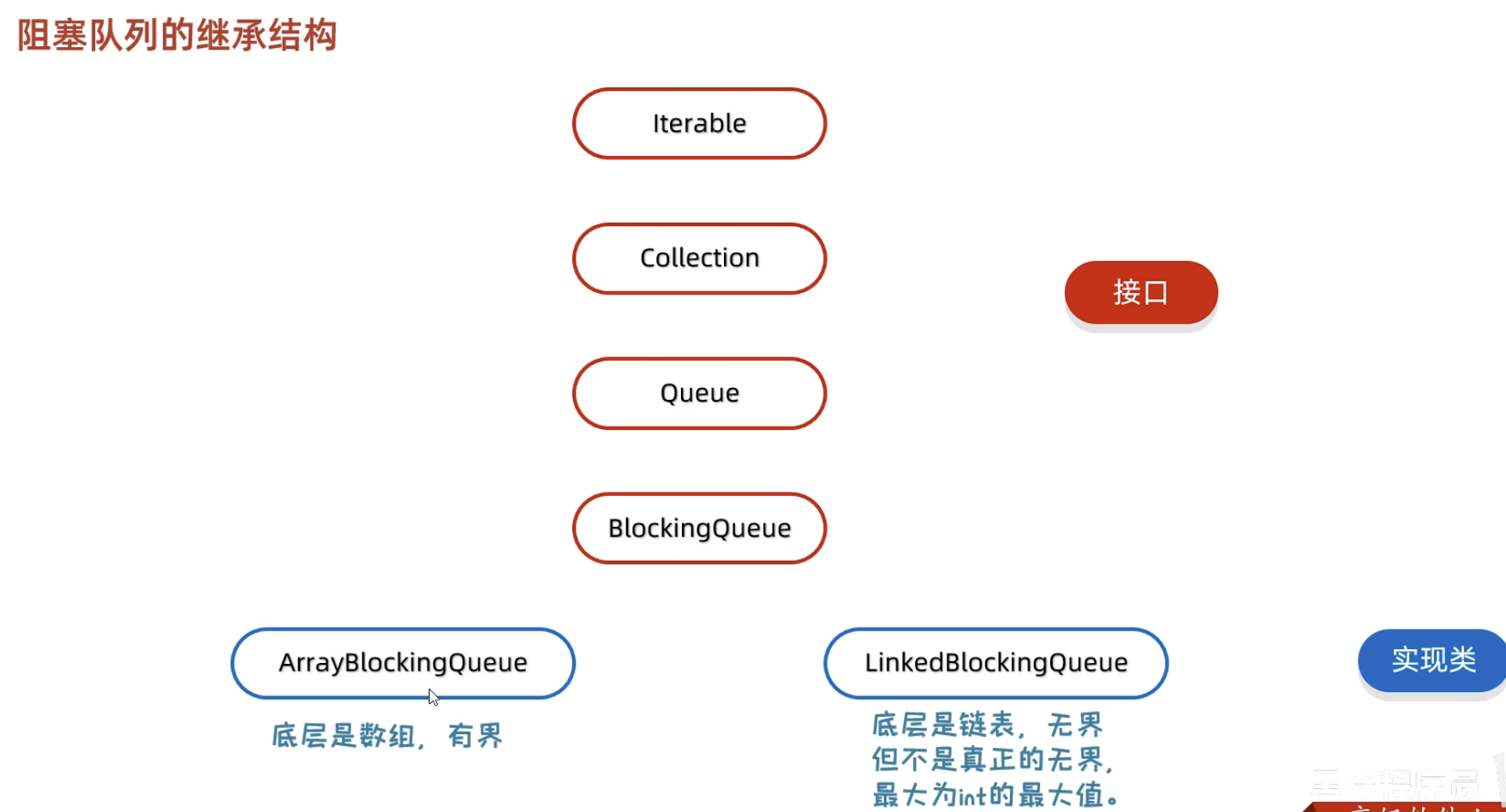敏而好学,不耻下问。
一、基本概念
进程:是正在运行的程序
- 独立性:进程是一个能独立运行的基本单位,同时也是系统分配资源和调度的独立单位
- 动态性:进程的实质是程序的一次执行过程,进程是动态产生,动态消亡的
- 并发性:任何进程都可以同其他进程一起并发执行
线程:是进程中的单个顺序控制流,是一条执行路径
单线程:一个进程如果只有一条执行路径,则称为单线程程序
多线程:一个进程如果有多条执行路径,则称为多线程程序
线程:是操作系统能够进行运算调度的最小单位。它被包含在进程之中,是进程中的实际运作单位
多线程的应用场景:
并发:在同一时刻,有多个指令在单个cpu上交替执行
并行:在同一时刻,有多个指令在多个cpu上同时执行
二、实现多线程
实现方式一:继承Thread类
步骤
- 自定义一个类继承
Thread
- 重写
run方法
- 创建子类的对象,并使用
start方法启动线程
1
2
3
4
5
6
7
8
9
10
11
12
13
14
15
16
17
18
19
20
21
22
| public class ThreadDemo {
public static void main(String[] args) {
MyThread t1 = new MyThread();
MyThread t2 = new MyThread();
t1.setName("线程1");
t2.setName("线程2");
t1.start();
t2.start();
}
}
---------------
public class MyThread extends Thread{
@Override
public void run() {
for (int i = 0; i < 100; i++) {
System.out.println(this.getName() + ": Hello world");
}
}
}
|
线程1: Hello world
线程2: Hello world
线程1: Hello world
线程1: Hello world
线程1: Hello world
线程1: Hello world
线程1: Hello world
······
「可以看到输出是两个线程交替进行的」
实现方式二:实现Runnable接口
步骤
- 自己定义一个类实现Runnable接口
- 重写里面的run方法
- 创建自己的类的对象
- 创建一个Thread类的对象,并开启线程
1
2
3
4
5
6
7
8
9
10
11
12
13
14
15
16
17
18
19
20
21
22
23
24
25
26
27
| public class ThreadDemo {
public static void main(String[] args) {
MyRun r = new MyRun();
Thread t1 = new Thread(r);
Thread t2 = new Thread(r);
t1.setName("线程1");
t2.setName("线程2");
t1.start();
t2.start();
}
}
------
public class MyRun implements Runnable{
@Override
public void run() {
for (int i = 0; i < 100; i++) {
Thread t = Thread.currentThread();
System.out.println(t.getName() + ": hello world");
}
}
}
|
线程2: hello world
线程1: hello world
线程2: hello world
线程2: hello world
线程2: hello world
线程2: hello world
······
「可以看到输出也是两个线程交替进行的」
实现方式三:利用Callable接口和Future接口
步骤
- 创建一个类MyCallable实现Callable接口
- 重写call(是有返回值的,表示多线程的运行结果)
- 创建MyCallable的对象(表示多线程的要执行的任务)
- 创建FutureTask的对象(作用管理多线程的的运行结果)
- 创建Thread类的对象,并启动(表示线程)
1
2
3
4
5
6
7
8
9
10
11
12
13
14
15
16
17
18
19
20
21
22
23
24
| public class ThreadDemo {
public static void main(String[] args) throws ExecutionException, InterruptedException {
MyCallable mc = new MyCallable();
FutureTask<Integer> ft = new FutureTask<>(mc);
Thread t1 = new Thread(ft);
t1.start();
Integer result = ft.get();
System.out.println(result);
}
}
-------
public class MyCallable implements Callable<Integer> {
@Override
public Integer call() throws Exception {
int sum = 0;
for (int i = 1; i <= 100; i++) {
sum += i;
}
return sum;
}
}
|
5050

常见的成员方法

1
2
3
4
5
6
7
8
9
10
11
12
13
14
15
16
17
18
19
20
21
22
23
24
25
26
27
28
29
30
31
32
33
34
35
36
37
38
39
40
41
42
43
44
45
46
47
48
| package a04threadmethod;
public class ThreadDemo {
public static void main(String[] args) throws InterruptedException {
MyThread t1 = new MyThread("ucas");
MyThread t2 = new MyThread("nssc");
t1.start();
t2.start();
}
}
-------
package a04threadmethod;
public class MyThread extends Thread{
public MyThread() {
}
public MyThread(String name) {
super(name);
}
@Override
public void run() {
for (int i = 0; i < 10; i++) {
try {
Thread.sleep(1000);
} catch (InterruptedException e) {
throw new RuntimeException(e);
}
System.out.println(getName() + "@ " + i);
}
}
}
|
抢占式调度,在jvm中,线程的优先级从1-10,默认为5,优先级越高,被选中执行的概率越大
1
2
3
4
5
6
7
8
9
10
11
12
13
14
15
16
17
18
19
20
21
22
23
24
25
26
27
28
29
30
| public class ThreadDemo {
public static void main(String[] args) {
MyRunnable mr = new MyRunnable();
Thread t1 = new Thread(mr, "ucas");
Thread t2 = new Thread(mr, "nssc");
t1.setPriority(1);
t2.setPriority(10);
t1.start();
t2.start();
}
}
-------
public class MyRunnable implements Runnable{
@Override
public void run() {
for (int i = 1; i <= 100; i++) {
System.out.println(Thread.currentThread().getName() + "---" + i);
}
}
}
|
守护线程:当其他的非守护线程执行完毕之后,守护线程会陆续结束
应用场景:在qq聊天界面中,聊天消息接发为线程1,文件传输中为线程2,当关闭聊天窗口时,如果线程2为守护线程,那么即使聊天窗口关闭(线程1结束),线程2仍会执行一直到完毕
1
2
3
4
5
6
7
8
9
10
11
12
13
14
15
16
17
18
19
20
21
22
23
24
25
26
27
28
29
30
31
32
33
34
35
36
37
38
39
40
41
42
43
| public class MyThread1 extends Thread{
@Override
public void run() {
for (int i = 1; i <= 10; i++) {
System.out.println(getName() + "@" + i);
}
}
}
------
public class MyThread2 extends Thread{
@Override
public void run() {
for (int i = 1; i <= 100; i++) {
System.out.println(getName() + "@" + i);
}
}
}
------
public class ThreadDemo {
public static void main(String[] args) {
MyThread1 t1 = new MyThread1();
MyThread1 t2 = new MyThread1();
MyThread2 t3 = new MyThread2();
t1.setName("女神1");
t2.setName("女神2");
t3.setName("备胎");
t3.setDaemon(true);
t1.start();
t2.start();
t3.start();
}
}
|
线程的生命周期

Q:sleep方法会让线程睡眠,睡眠时间到了之后,立马就会执行该线程的代码吗?
A:不会,此时线程会进入就绪状态,需要抢夺刀cpu的执行权后才能执行
三、线程安全问题
需求:某电影院正在上映国产大片,共有100张票,而它有3个窗口卖票,请设计一个程序模拟该电影院卖票
1
2
3
4
5
6
7
8
9
10
11
12
13
14
15
16
17
18
19
20
21
22
23
24
25
26
27
28
29
30
31
32
33
34
35
36
| public class MyThread extends Thread{
static int ticket = 0;
@Override
public void run() {
while(true){
if(ticket < 100){
ticket ++;
System.out.println(getName() + "正在卖第" + ticket + "张票!!!");
} else {
break;
}
}
}
}
------
public class ThreadDemo {
public static void main(String[] args) {
MyThread t1 = new MyThread();
MyThread t2 = new MyThread();
MyThread t3 = new MyThread();
t1.setName("窗口1");
t2.setName("窗口2");
t3.setName("窗口3");
t1.start();
t2.start();
t3.start();
}
}
|
······
窗口2正在卖第96张票!!!
窗口2正在卖第97张票!!!
窗口3正在卖第94张票!!!
窗口3正在卖第99张票!!!
窗口3正在卖第100张票!!!
窗口1正在卖第90张票!!!
窗口2正在卖第99张票!!!
我们可以看出这样是有问题的,同一张票被两个窗口卖出过,于是我们就需要对共享数据上锁
1
2
3
4
5
6
7
8
9
10
11
12
13
14
15
16
17
18
19
20
21
22
| public class MyThread extends Thread{
static int ticket = 0;
static Object obj = new Object();
@Override
public void run() {
while(true){
synchronized(obj){
if(ticket < 100){
ticket ++;
System.out.println(getName() + "正在卖第" + ticket + "张票!!!");
} else {
break;
}
}
}
}
}
|
注意:
synchronized的地方要写对,什么时候上锁是有讲究的,例如如果上面的例子,锁上在while外面的话,结果将是窗口1卖完所有的100张票就直接结束了- 锁对象可以任意,但是一定要保持唯一,这是因为,要保证所有线程看到的都是同一把锁
同步方法:将synchronized关键字加到方法上
特点1:同步方法是锁住方法里面的所有代码
特点2:锁对象不能自己指定 如果是非静态方法,锁对象为this,如果是静态方法,锁对象为当前类的文件对象
对上述需求使用同步方法完成
1
2
3
4
5
6
7
8
9
10
11
12
13
14
15
16
17
18
19
20
21
22
23
24
25
26
27
28
29
30
31
32
33
34
| package a05threadsafe1;
public class MyThread extends Thread{
static int ticket = 0;
static Object obj = new Object();
@Override
public void run() {
while(true){
synchronized(obj){
try {
if (method()) break;
} catch (InterruptedException e) {
throw new RuntimeException(e);
}
}
}
}
private boolean method() throws InterruptedException {
if(ticket < 100){
Thread.sleep(100);
ticket ++;
System.out.println(getName() + "正在卖第" + ticket + "张票!!!");
} else {
return true;
}
return false;
}
}
|
四、Lock锁
Lock中提供了获得锁和释放锁的方法
获得锁:void lock()
释放锁:void unlock()
由于Lock是接口,不能直接实例化,于是采用它的实现类ReentrantLock来实例化
1
2
3
4
5
6
7
8
9
10
| static Lock lock = new ReentrantLock();
lock.lock();
try {
} catch (InterruptedException e){
e.printStackTrace();
} finally {
lock.unlock();
}
|
五、死锁
1
2
3
4
5
6
7
8
9
10
11
12
13
14
15
16
17
18
19
20
21
22
23
24
25
26
27
28
| public class Demo {
public static void main(String[] args) {
Object objA = new Object();
Object objB = new Object();
new Thread(()->{
while(true){
synchronized (objA){
synchronized (objB){
System.out.println("小康同学正在走路");
}
}
}
}).start();
new Thread(()->{
while(true){
synchronized (objB){
synchronized (objA){
System.out.println("小薇同学正在走路");
}
}
}
}).start();
}
}
|
六、生产者和消费者(等待唤醒机制)
| 方法名称 |
说明 |
| void wait() |
当前线程等待,直到被其他线程唤醒 |
| void notify() |
随机唤醒单个线程 |
| void notifyAll() |
唤醒所有线程 |

需求:完成生产者和消费者(等待唤醒机制)的代码,实现线程轮流交替执行的结果
ThreadDemo.java
1
2
3
4
5
6
7
8
| public class ThreadDemo {
public static void main(String[] args) {
Foodie foodie = new Foodie();
Cook cook = new Cook();
foodie.start();
cook.start();
}
}
|
Desk.java
1
2
3
4
5
6
7
8
9
10
11
12
| public class Desk {
public static int foodFlag = 0;
public static int count = 10;
public static Object lock = new Object();
}
|
Foodie.java
1
2
3
4
5
6
7
8
9
10
11
12
13
14
15
16
17
18
19
20
21
22
23
24
25
26
27
28
29
30
31
32
| public class Foodie extends Thread{
@Override
public void run() {
while(true){
synchronized (Desk.lock){
if(Desk.count == 0){
break;
} else {
if(Desk.foodFlag == 0){
try {
Desk.lock.wait();
} catch (InterruptedException e) {
throw new RuntimeException(e);
}
} else {
Desk.count --;
System.out.println("正在吃面条,还能吃" + Desk.count + "碗!!!");
Desk.lock.notify();
Desk.foodFlag = 0;
}
}
}
}
}
}
|
Cook.java
1
2
3
4
5
6
7
8
9
10
11
12
13
14
15
16
17
18
19
20
21
22
23
24
25
26
27
28
29
30
| public class Cook extends Thread{
@Override
public void run() {
while(true){
synchronized(Desk.lock){
if(Desk.count == 0){
break;
} else {
if(Desk.foodFlag == 1){
try {
Desk.lock.wait();
} catch (InterruptedException e) {
throw new RuntimeException(e);
}
} else {
System.out.println("厨师做了一碗面条");
Desk.lock.notify();
Desk.foodFlag = 1;
}
}
}
}
}
}
|
厨师做了一碗面条
正在吃面条,还能吃9碗!!!
厨师做了一碗面条
正在吃面条,还能吃8碗!!!
厨师做了一碗面条
正在吃面条,还能吃7碗!!!
厨师做了一碗面条
正在吃面条,还能吃6碗!!!
厨师做了一碗面条
正在吃面条,还能吃5碗!!!
厨师做了一碗面条
正在吃面条,还能吃4碗!!!
厨师做了一碗面条
正在吃面条,还能吃3碗!!!
厨师做了一碗面条
正在吃面条,还能吃2碗!!!
厨师做了一碗面条
正在吃面条,还能吃1碗!!!
厨师做了一碗面条
正在吃面条,还能吃0碗!!!
使用阻塞队列实现

阻塞队列底层就是用锁实现的,于是不用开发者手动加锁
ThreadDemo.java
1
2
3
4
5
6
7
8
9
10
11
12
13
14
15
16
| import java.util.concurrent.ArrayBlockingQueue;
public class ThreadDemo {
public static void main(String[] args) {
ArrayBlockingQueue<String> queue = new ArrayBlockingQueue<>(1);
Cook c = new Cook(queue);
Foodie f = new Foodie(queue);
c.start();
f.start();
}
}
|
Foodie.java
1
2
3
4
5
6
7
8
9
10
11
12
13
14
15
16
17
18
19
20
21
22
23
24
| import java.util.concurrent.ArrayBlockingQueue;
public class Foodie extends Thread{
ArrayBlockingQueue<String> queue;
public Foodie(ArrayBlockingQueue<String> queue) {
this.queue = queue;
}
@Override
public void run() {
while (true) {
try {
String food = queue.take();
System.out.println(food);
} catch (InterruptedException e) {
throw new RuntimeException(e);
}
}
}
}
|
Cook.java
1
2
3
4
5
6
7
8
9
10
11
12
13
14
15
16
17
18
19
20
21
22
| import java.util.concurrent.ArrayBlockingQueue;
public class Cook extends Thread{
ArrayBlockingQueue<String> queue;
public Cook(ArrayBlockingQueue<String> queue) {
this.queue = queue;
}
@Override
public void run() {
while (true) {
try {
queue.put("面条");
System.out.println("厨师制作好了一碗面条");
} catch (InterruptedException e) {
throw new RuntimeException(e);
}
}
}
}
|
线程的六大状态
新建状态(NEW) -------> 创建线程对象
就绪状态(RUNNABLE) ------> start方法
阻塞状态 (BLOCKED) ------> 无法获得锁对象
等待状态(WAITING) ------> wait方法
计时等待(TIMED_WAITING) ------> sleep方法
结束状态(TERMINATED) ------> 全部代码运行完毕
七、多线程练习题
练习01
需求:一共有1000张电影票,可以在两个窗口领取,假设每次领取的时间为3000毫秒,
要求:请用多线程模拟卖票过程并打印剩余电影票的数量
MyThread.java
1
2
3
4
5
6
7
8
9
10
11
12
13
14
15
16
17
18
19
20
21
22
23
24
| public class MyThread extends Thread{
public static int count = 1000;
@Override
public void run() {
while (true) {
synchronized (MyThread.class) {
if(count == 0){
break;
} else {
try {
Thread.sleep(3000);
} catch (InterruptedException e) {
throw new RuntimeException(e);
}
System.out.println(getName() + "卖出一张票");
count --;
System.out.println("当前剩余票数:" + count + "张");
}
}
}
}
}
|
ThreadDemo.java
1
2
3
4
5
6
7
8
9
10
11
12
13
14
15
16
17
18
19
| public class ThreadDemo {
public static void main(String[] args) {
MyThread t1 = new MyThread();
MyThread t2 = new MyThread();
t1.setName("窗口1");
t2.setName("窗口2");
t1.start();
t2.start();
}
}
|
练习02
需求:有100份礼品,两人同时发送,当剩下的礼品小于10份的时候则不再送出,利用多 线程模拟该过程并将线程的名字和礼物的剩余数量打印出来.
MyRun.java
1
2
3
4
5
6
7
8
9
10
11
12
13
14
15
16
17
18
19
20
21
22
23
| public class MyRun implements Runnable{
public int count = 100;
@Override
public void run() {
while (true){
synchronized (MyRun.class) {
if(count <= 10) break;
else {
try {
Thread.sleep(1000);
} catch (InterruptedException e) {
throw new RuntimeException(e);
}
count --;
System.out.println(Thread.currentThread().getName() + "正在发送礼品... 此时礼品剩余数量" + count);
}
}
}
}
}
|
ThreadDemo.java
1
2
3
4
5
6
7
8
9
10
11
12
13
14
15
16
17
18
19
20
21
| import a08practice01.MyThread;
public class ThreadDemo {
public static void main(String[] args) {
MyRun mr = new MyRun();
Thread t1 = new Thread(mr);
Thread t2 = new Thread(mr);
t1.setName("窗口1");
t2.setName("窗口2");
t1.start();
t2.start();
}
}
|
练习03
需求:同时开启两个线程,共同获取1-100之间的所有数字。要求:将输出所有的奇数。
MyRun.java
1
2
3
4
5
6
7
8
9
10
11
12
13
14
15
16
17
18
19
20
21
22
23
| public class MyRun implements Runnable{
public int num = 100;
@Override
public void run() {
while (true){
synchronized (MyRun.class){
if(num < 1) break;
else {
try {
Thread.sleep(1000);
} catch (InterruptedException e) {
throw new RuntimeException(e);
}
if(num % 2 == 1) System.out.println(Thread.currentThread().getName() + "@ " + num);
num --;
}
}
}
}
}
|
ThreadDemo.java
1
2
3
4
5
6
7
8
9
10
11
12
13
14
15
16
17
| package a08practice03;
public class ThreadDemo {
public static void main(String[] args) {
MyRun mr = new MyRun();
Thread t1 = new Thread(mr);
Thread t2 = new Thread(mr);
t1.setName("窗口1");
t2.setName("窗口2");
t1.start();
t2.start();
}
}
|
练习04
抢红包
1
2
3
4
5
6
7
8
9
10
11
| 需求:
微信中的抢红包也用到了多线程。
假设:100块,分成了3个包,现在有5个人去抢。
其中,红包是共享数据。
5个人是5条线程。
打印结果如下:
XXX抢到了XXX元
XXX抢到了XXX元
XXX抢到了XXX元
XXX没抢到
XXX没抢到
|
ThreadDemo.java
1
2
3
4
5
6
7
8
9
10
11
12
13
14
15
16
17
18
19
20
21
22
23
24
| import java.util.ArrayList;
import java.util.List;
import java.util.Random;
public class ThreadDemo {
public static void main(String[] args) {
MyThread t1 = new MyThread();
MyThread t2 = new MyThread();
MyThread t3 = new MyThread();
MyThread t4 = new MyThread();
MyThread t5 = new MyThread();
t1.setName("苏无名");
t2.setName("樱桃");
t3.setName("卢凌风");
t4.setName("裴喜君");
t5.setName("费鸡师");
t1.start();
t2.start();
t3.start();
t4.start();
t5.start();
}
}
|
MyThread.java
1
2
3
4
5
6
7
8
9
10
11
12
13
14
15
16
17
18
19
20
21
22
23
24
25
26
27
28
29
30
31
32
33
34
35
| import java.util.Random;
public class MyThread extends Thread{
static int money = 10000;
static int num = 3;
static final int MIN = 1;
@Override
public void run() {
synchronized (MyThread.class){
if(num <= 0) {
System.out.println("很遗憾~" + getName() + "没有抢到红包~");
} else {
try {
Thread.sleep(1000);
} catch (InterruptedException e) {
throw new RuntimeException(e);
}
int prize = 0;
if(num == 1) prize = money;
else {
Random r = new Random();
int bounds = money - (num - 1) * MIN;
prize = r.nextInt(bounds);
if(prize < MIN) prize = MIN;
}
money -= prize;
num --;
System.out.println("恭喜 " + getName() + " 抢到红包" + prize / 100.0 + "元!!!");
}
}
}
}
|
练习05
抽奖箱抽奖
1
2
3
4
5
6
7
8
9
10
| 有一个抽奖池,该抽奖池中存放了奖励的金额,该抽奖池中的奖项为 {10,5,20,50,100,200,500,800,2,80,300,700};
创建两个抽奖箱(线程)设置线程名称分别为“抽奖箱1”,“抽奖箱2”
随机从抽奖池中获取奖项元素并打印在控制台上,格式如下:
每次抽出一个奖项就打印一个(随机)
抽奖箱1 又产生了一个 10 元大奖
抽奖箱1 又产生了一个 100 元大奖
抽奖箱1 又产生了一个 200 元大奖
抽奖箱1 又产生了一个 800 元大奖
抽奖箱2 又产生了一个 700 元大奖
.....
|
ThreadDemo.java
1
2
3
4
5
6
7
8
9
10
11
12
13
14
15
16
17
18
| import a08practice05.MyThread;
import java.util.ArrayList;
import java.util.Collections;
public class ThreadDemo {
public static void main(String[] args) {
ArrayList<Integer> list = new ArrayList<>();
Collections.addAll(list, 10,5,20,50,100,200,500,800,2,80,300,700);
MyThread t1 = new MyThread(list);
MyThread t2 = new MyThread(list);
t1.setName("抽奖箱1");
t2.setName("抽奖箱2");
t1.start();
t2.start();
}
}
|
MyThread.java
1
2
3
4
5
6
7
8
9
10
11
12
13
14
15
16
17
18
19
20
21
22
23
24
25
26
27
28
29
30
31
32
| import java.util.ArrayList;
import java.util.Collections;
public class MyThread extends Thread{
ArrayList<Integer> list;
public MyThread(ArrayList<Integer> list) {
this.list = list;
}
@Override
public void run() {
while(true){
synchronized (MyThread.class){
if(list.size() == 0) {
break;
} else {
Collections.shuffle(list);
int prize = list.remove(0);
System.out.println(getName() + " 又产生了一个 " + prize + " 元大奖!!!");
}
}
try {
Thread.sleep(10);
} catch (InterruptedException e) {
throw new RuntimeException(e);
}
}
}
}
|
练习06
多线程统计并求最大值
1
2
3
4
5
6
7
| 有一个抽奖池,该抽奖池中存放了奖励的金额,该抽奖池中的奖项为 {10,5,20,50,100,200,500,800,2,80,300,700};
创建两个抽奖箱(线程)设置线程名称分别为“抽奖箱1”,“抽奖箱2”
随机从抽奖池中获取奖项元素并打印在控制台上,格式如下:
每次抽的过程中,不打印,抽完时一次性打印(随机) 在此次抽奖过程中,抽奖箱1总共产生了6个奖项。
分别为:10,20,100,500,2,300最高奖项为300元,总计额为932元
在此次抽奖过程中,抽奖箱2总共产生了6个奖项。
分别为:5,50,200,800,80,700最高奖项为800元,总计额为1835元
|
ThreadDemo.java
1
2
3
4
5
6
7
8
9
10
11
12
13
14
15
| import java.util.ArrayList;
import java.util.Collections;
public class ThreadDemo {
public static void main(String[] args) {
ArrayList<Integer> list = new ArrayList<>();
Collections.addAll(list, 10,5,20,50,100,200,500,800,2,80,300,700);
MyThread t1 = new MyThread(list);
MyThread t2 = new MyThread(list);
t1.setName("抽奖箱1");
t2.setName("抽奖箱2");
t1.start();
t2.start();
}
}
|
MyThread.java
1
2
3
4
5
6
7
8
9
10
11
12
13
14
15
16
17
18
19
20
21
22
23
24
25
26
27
28
29
30
31
32
33
34
35
36
37
| import java.util.ArrayList;
import java.util.Collections;
public class MyThread extends Thread{
ArrayList<Integer> list;
public MyThread(ArrayList<Integer> list) {
this.list = list;
}
@Override
public void run() {
ArrayList<Integer> boxlist = new ArrayList<>();
while(true){
synchronized (a08practice05.MyThread.class){
if(list.size() == 0) {
boxlist.sort(Integer::compareTo);
int MAX = boxlist.get(boxlist.size() - 1);
int sum = boxlist.stream().mapToInt(Integer::intValue).sum();
System.out.println("抽奖箱1"+ boxlist + " 最高金额 " + MAX + " 总金额 " + sum);
break;
} else {
Collections.shuffle(list);
int prize = list.remove(0);
boxlist.add(prize);
}
}
try {
Thread.sleep(10);
} catch (InterruptedException e) {
throw new RuntimeException(e);
}
}
}
}
|
八、线程池
线程池主要核心原理:
- 创建一个池子,池子是空的
- 提交任务时,池子会创建新的线程对象,任务执行完毕,线程归还给池子,下次在提交任务时,不需要创建新的线程,直接复用已有的线程即可
- 但是如果提交任务时,池子中没有空闲线程,也无法创建新的线程,任务就会排队等候
线程池实现步骤
-
创建线程池
Executors:线程池的工具类通过调用方法返回不同类型的线程池对象
| 方法名称 |
说明 |
public static ExecutorService newCachedThreadPool() |
创建一个没有上限的线程池 |
public static ExecutorService new FixedThreadPool(int nThreads) |
创建有上限的线程池 |
-
提交任务
-
所有的任务全部执行完毕,关闭线程池
九、自定义线程池
ThreadPoolExecutor threadPoolExecutor = new ThreadPoolExecutor
(核心线程数量,最大线程数量,空闲线程最大存活时间,任务队列,创建线程工厂,任务的拒绝策略);
参数一:核心线程数量 不能小于0
参数二:最大线程数 不能小于0,最大数量 >= 核心线程数量
参数三:空闲线程最大存活时间 不能小于0
参数四:时间单位 用TimeUnit指定
参数五:任务队列 不能为null
参数六:创建线程工厂 不能为null
参数七:任务的拒绝策略 不能为null
1
2
3
4
5
6
7
8
9
| ThreadPoolExecutor pool = new ThreadPoolExecutor(
3,
6,
60,
TimeUnit.SECONDS,
new ArrayBlockingQueue<>(3),
Executors.defaultThreadFactory(),
new ThreadPoolExecutor.AbortPolicy()
);
|

不断的提交任务,会有三个临界点:
- 当核心线程满时,在提交任务就会排队
- 当核心线程满,队伍满时,会创建临时线程
- 当核心线程满,队伍满时,临时线程满时,会触发任务拒绝策略















